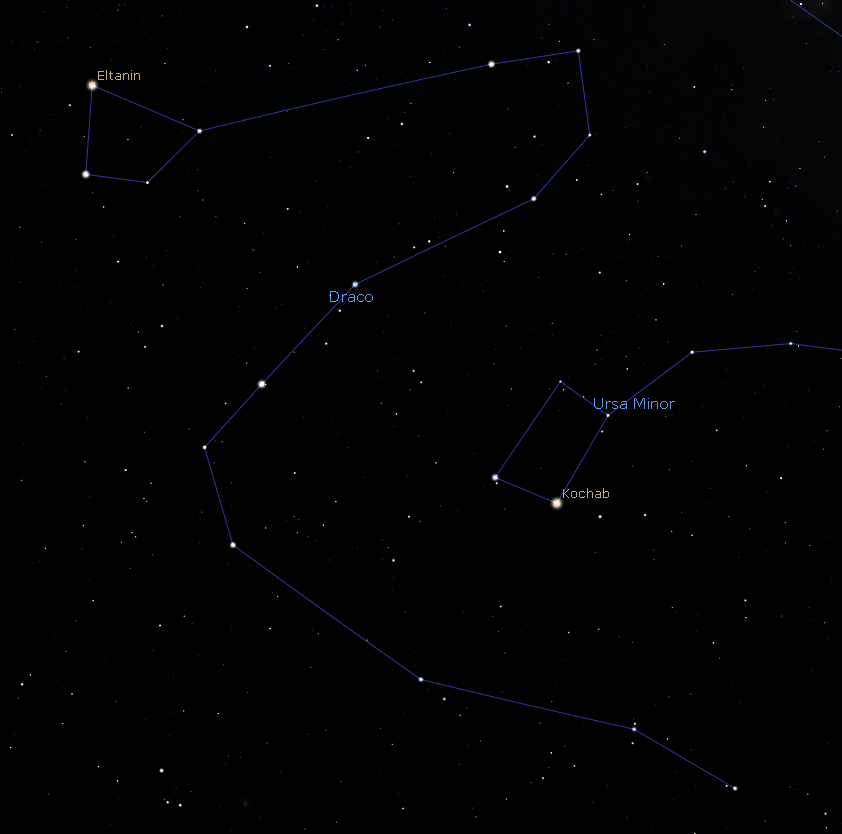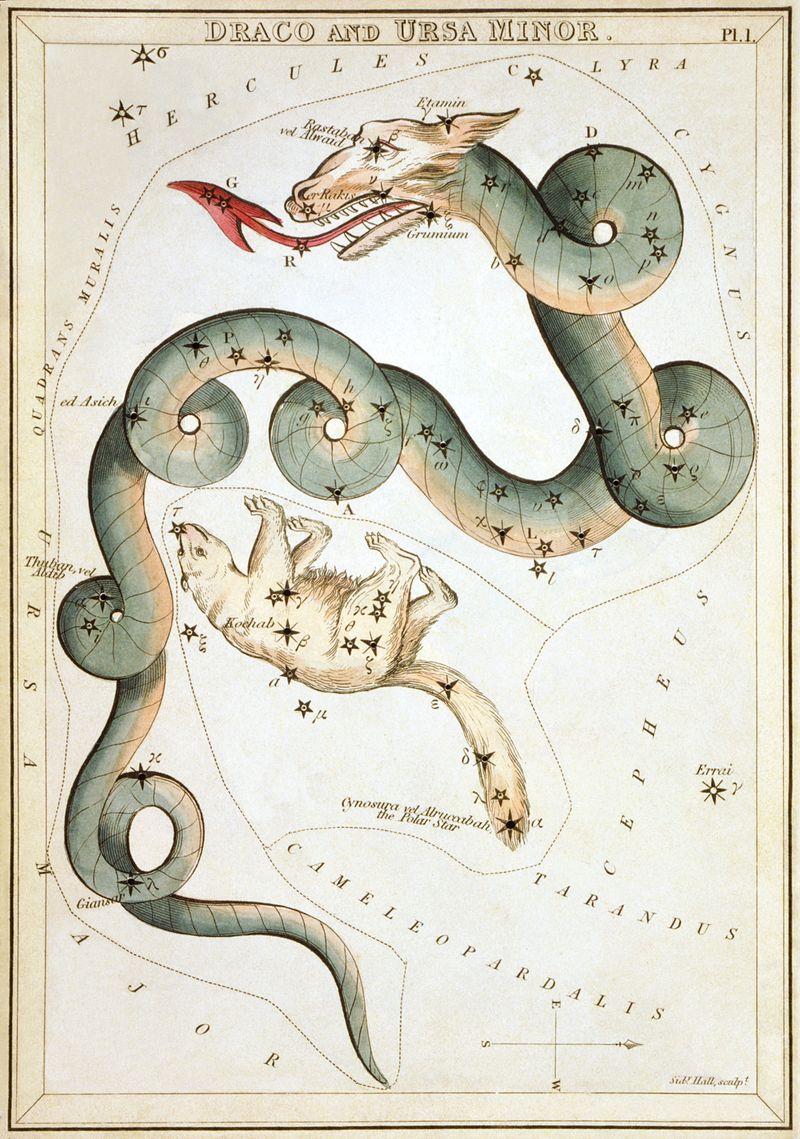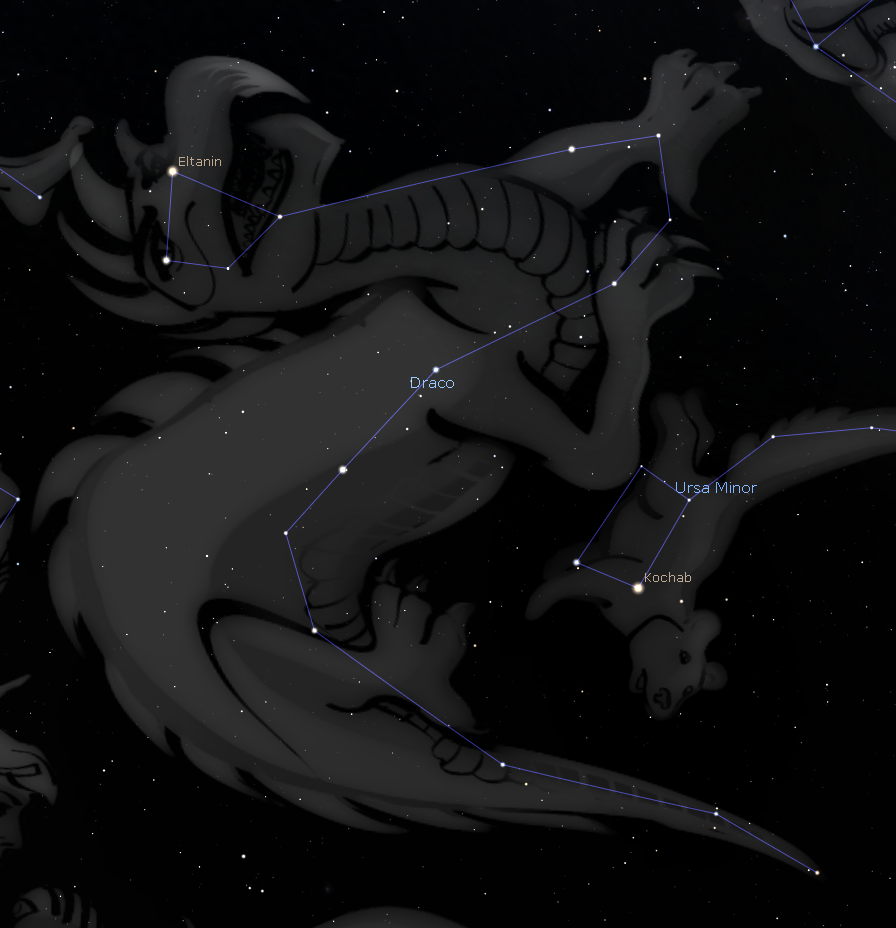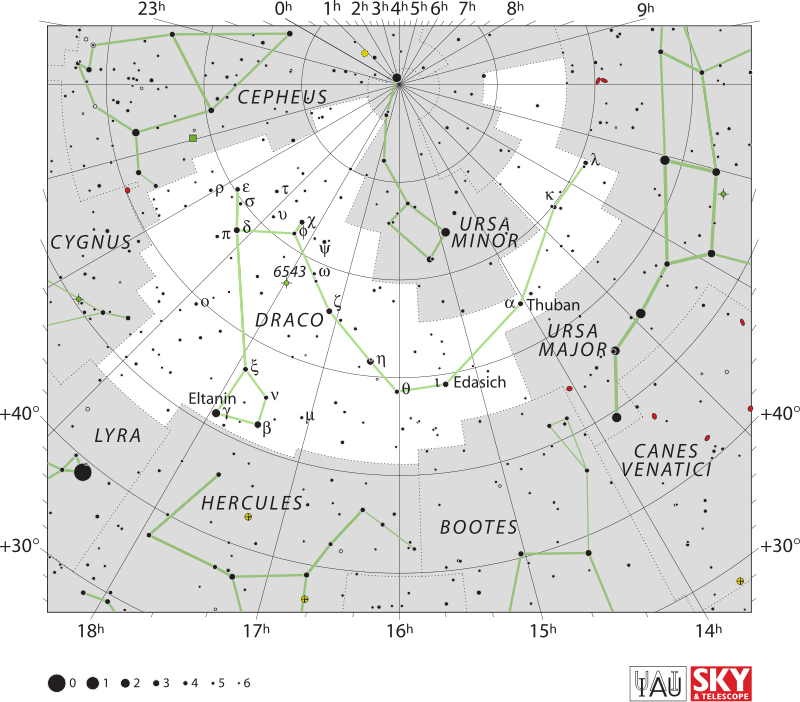|
Draco is a constellation that can be seen in the far north. Its name means "dragon" in Latin. It was one of the forty-eight constellations listed by Claudius Ptolemy in the second century, and it is now one of the eighty-eight current constellations. Draco is home to the ecliptic's north pole. (Ridpath & Tirion 2001) Draco is circumpolar (meaning it never sets) and visible all year in northern latitudes.
|
|
History and Mythology
Draco (also known as Ancient Greek: Ὄφις, romanized: Ophis, lit. 'serpent') is one of the forty-eight constellations named in Claudiud Ptolemy's Almagest (second century), which Eudoxus of Cnidus adopted from the list (fourth century BC). In Greek mythology, Draco was associated with several different dragons. According to Gaius Julius Hyginus' De Astronomica, it was one of the Gigantes that fought the Olympian gods for ten years in the Gigantomachy until being murdered and sent into the sky by the goddess Athena. The dragon became twisted on itself when Athena hurled it, and it froze in the icy North Celestial Pole before it could right itself. (Staal 1988) Aelius Aristides gives him the moniker Aster ('star' or 'starry') and claims that Athens' Great Panathenaea festival commemorated Athena's victory against him. As seen from the Athenian Acropolis, the event coincided with the conclusion of the constellation's head. Draco is identified as Ladon, the dragon who guarded the Hesperides' golden apples, according to the Catasterismi attributed to Eratosthenes. (Staal 1988) Heracles killed Ladon when he was charged with taking the golden apples during his twelve labours, and Hera changed Ladon into a constellation. Hercules is shown in the heavens with one foot on Draco's head. Draco is sometimes shown as Typhon, Gaia's hideous son. (Staal 1988) In modern-day Draco, which is known as the Mother Camels, traditional Arabic astronomy does not portray a dragon. Instead, two hyenas, Eta Draconis and Zeta Draconis are seen assaulting a newborn camel (a faint star near Beta Draconis), which is guarded by four female camels, Beta Draconis, Gamma Draconis, Nu Draconis, and Xi Draconis. A cooking tripod made from Upsilon, Tau, and Sigma Draconis represents the nomads who own the camels, who are camped nearby. (Staal 1988) However, Arabic astronomers were aware of the Greek interpretation of the constellation, referring to it as At-Tinnin ('the dragon') in Arabic, which is the source of Gamma Draconis' formal name, Eltanin, derived from ras al-tinnn ('the dragon's head'). The US Navy's Crater class cargo ship Draco was named after the constellation. This constellation gives its name to the main character in the 1996 film Dragonheart. Draco is also revealed to be dragon heaven, where dragons go when their time on Earth is over if they have fulfilled an old dragon's duty to protect mankind, with dragons otherwise fading into nothing when they die. Draco, the last dragon, ascends into the constellation at the end of the film after sacrificing himself to slay an evil monarch he had protected years before. This is expanded upon in the subsequent sequel and prequel flicks. Russian chess master Fyodor Dus-Chotimirsky called the Dragon Variation of the Sicilian Defence chess opening after the constellation. (Gufeld 1998) The Draco constellation is inspired/based on the Beyblade top Lightning L-Drago 100HF and its evolutions Meteo L-Drago LW105LF and L-Drago Destructor F:S. They all have three dragon heads chasing each other in a counter-clockwise pattern, presumably alluding to Ladon's many heads. Another bey inspired by/based on the Draco constellation is Omega Dragonis 85XF. The constellation is also called after Draco Malfoy, a villain in the Harry Potter books. |
|
Deep-sky Objects
NGC 6543 – Cat’s Eye Nebula – Planetary Nebula
NGC 5866 – Lenticular Galaxy (questionably identified as Messier 102)
PGC 39058 – Faint Dwarf Galaxy
NGC 5879 – Unbarred Spiral Galaxy
NGC 5907 – Spiral Galaxy
Abell 2218 – Massive Galaxy Cluster
Arp 188 – Tadpole Galaxy – Disrupted Barred Spiral Galaxy which is merging with a nearby galaxy
Main stars - 14
Bayer stars - 76
Stars with planets - 19
Stars brighter than magnitude 3.00 - 3
Stars within 32 Ly - 0
Bordering
constellations
NGC 6543 – Cat’s Eye Nebula – Planetary Nebula
NGC 5866 – Lenticular Galaxy (questionably identified as Messier 102)
PGC 39058 – Faint Dwarf Galaxy
NGC 5879 – Unbarred Spiral Galaxy
NGC 5907 – Spiral Galaxy
Abell 2218 – Massive Galaxy Cluster
Arp 188 – Tadpole Galaxy – Disrupted Barred Spiral Galaxy which is merging with a nearby galaxy
Main stars - 14
Bayer stars - 76
Stars with planets - 19
Stars brighter than magnitude 3.00 - 3
Stars within 32 Ly - 0
Bordering
constellations
- Boötes
- Hercules
- Lyra
- Cygnus
- Cepheus
- Ursa Minor
- Camelopardalis
- Ursa Major



